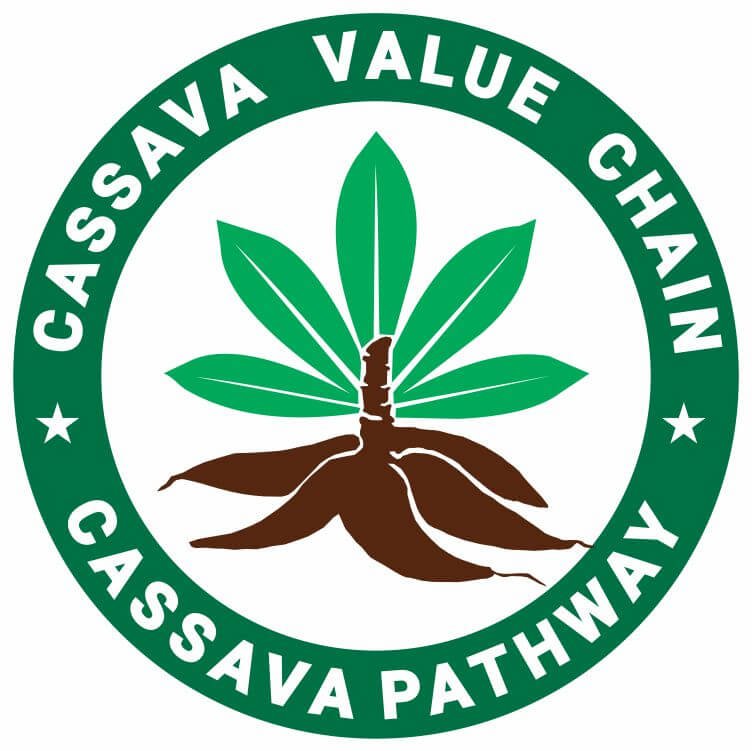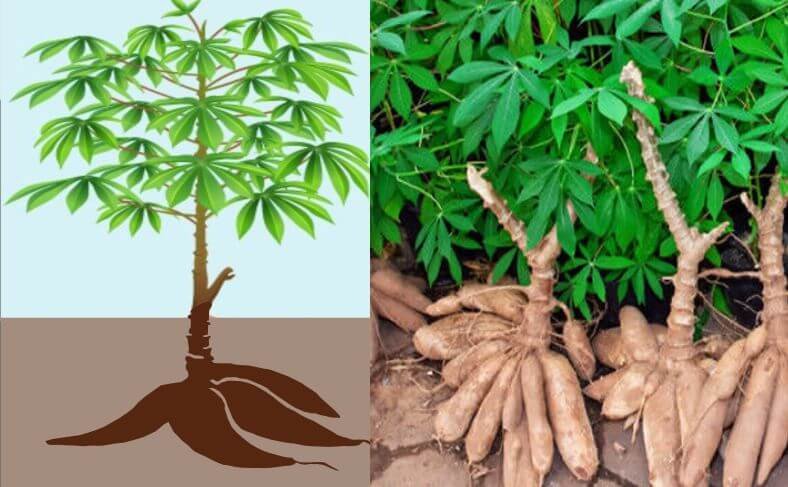What is cassava? Discover everything about this supercrop that is a global staple, its benefits, cultivation, and uses. Learn why and how manioc fuels industries worldwide.
Cassava is the most basic, abundant, cheap, and easy-to-make food crop in my country and community.
In my state, every family eats a kind of cassava food every day. The relationship we have with yuca is a sacred one, and not even death can come between.
This explains my passion for this supercrop that is provided by Providence so everyone can survive.
Cassava feeds over 800 million people, making it one of the world’s most important staple crops.
It thrives in tough conditions, ensuring food security where other crops fail. But beyond its role as a survival crop, cassava drives industries, fueling businesses in food production, biofuels, textiles, and more.
Farmers rely on it for their livelihoods, while consumers enjoy it in countless traditional dishes.
From garri and fufu to tapioca and starch, cassava’s uses are endless. However, challenges like processing inefficiencies and disease threats still exist.
This guide answers the question: What is cassava? … and covers everything about manioc, including its varieties, nutritional benefits, farming techniques, economic impact, and future innovations.
Whether you’re a farmer, entrepreneur, or curious reader, this is your go-to resource on cassava.
Recommended: Cassava in the United States: Use, Cultivation and Health
Table of Contents
- Main Points
- What is Cassava, the Yuca Plant?
- Cassava Varieties and Types
- Cassava – Yuca Plant – My Town’s Most Favorite Crop
- Botanical Description and Taxonomy of the Cassava Tapioca Plant
- Physical Description of Cassava Plant
- Nutritional Value of Cassava
- Cassava and Food Security
- How Cassava is Grown
- Cassava Harvesting and Post-Harvest Handling
- Traditional & Modern Uses of Cassava
- Processing Cassava: From Root to Product
- Economic Importance of Cassava
- Challenges in Cassava Farming & Solutions
- Future Innovation in Cassava Farming
- Environmental Impact & Sustainability
- Cassava in Global Cuisine (Cassava Recipes)
- Health Concerns & Allergies of Cassava
- Cassava Entrepreneurship (Business Farming)
- Cassava, Plastics, Energy, and the Future
- Cassava vs Similar Crops
- Frequently Asked Questions
- Conclusion
Main Points
- Cassava feeds over 800 million people worldwide, thriving in harsh climates where other crops fail, ensuring food security in many regions.
- Sweet cassava is safe to eat after simple cooking, while bitter cassava requires processing to remove harmful cyanogenic compounds before consumption.
- Cassava is rich in carbohydrates, fiber, and vitamin C but low in protein and fats, requiring complementary foods for a balanced diet.
- Cassava supports industries such as food production, biofuels, textiles, and animal feed, making it a key economic driver in many countries.
- Cassava is easy to grow but faces challenges like processing inefficiencies, pests, and diseases that can impact yield and food safety.
What is Cassava, the Yuca Plant?
Cassava (Manihot esculenta) is a starchy root crop from the Euphorbiaceae family, also known as yuca, mandioca, manioc, or tapioca, widely grown in tropical and subtropical regions for its gluten-free products, and can be baked, cooked, or fried.
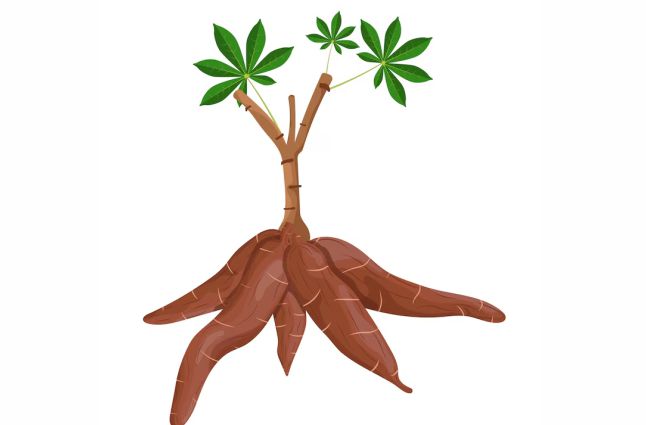
First domesticated in South America, it was later introduced to Africa and Asia by Portuguese traders, where it became a dietary staple.
Its resilience sets it apart; cassava thrives in poor soil, withstands drought, and requires minimal inputs, making it a lifeline for millions in food-insecure regions.
Beyond sustenance, cassava supports global industries, providing raw materials for flour, starch, ethanol, and animal feed.
Packed with calories, vitamins, and minerals, it is the darling of the tropical population because of its numerous products.
Whether boiled, pounded, fermented, or processed into derivatives like tapioca, this root crop remains indispensable, shaping economies and feeding populations across continents.
Recommended: How to Process Cassava
Cassava Varieties and Types
Cassava varieties are broadly classified based on characteristics like cyanide content, climate adaptability, and end use.
The variety you choose determines yield, market value, processing suitability, and even shelf life.
Below are the main types of cassava, each with a detailed cluster post linked at the end.
Bitter vs Sweet Cassava
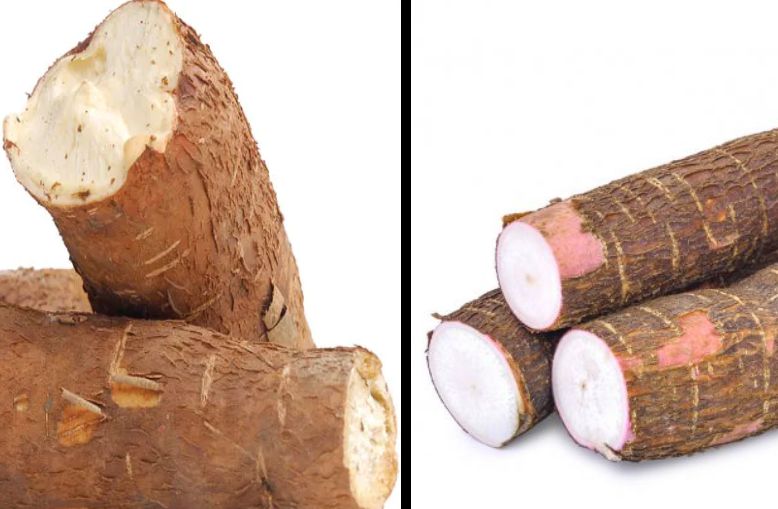
Cassava is generally classified into bitter and sweet cassava types. The key difference is in their cyanide levels.
Bitter cassava has a high cyanogenic content and must be properly processed to avoid poisoning.
It is best suited for industrial uses such as starch production, animal feed, and bioethanol.
Sweet cassava has a much lower cyanide level and is easier to process into food products like fufu, garri, and cassava flour.
Farmers often grow sweet cassava for direct consumption and small-scale food processing, while bitter types are grown in regions with processing industries.
Both types differ in taste, yield, and market preferences.
Selecting the right one depends on your goals, food, or commercial processing.
👉 Read more about Bitter vs Sweet Cassava →
Improved Hybrid Cassava
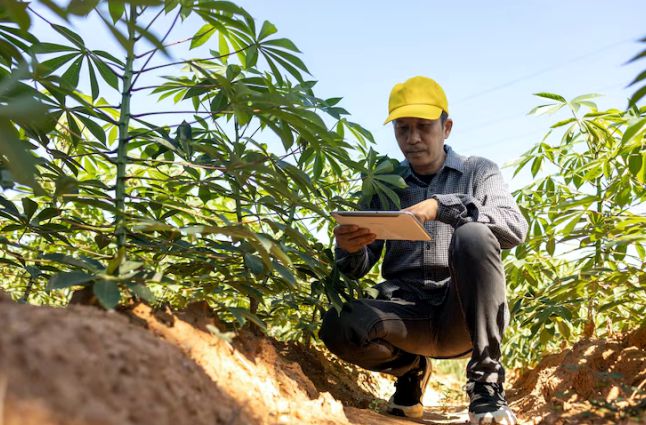
Improved hybrid cassava varieties are bred to solve specific farming and market challenges.
These improved types are developed by research institutes such as IITA and national agricultural programs.
Hybrids offer higher yields, shorter maturity times, disease resistance, and improved tolerance to harsh weather.
Many are designed to reduce post-harvest deterioration, a common issue in cassava that affects commercial processing.
Farmers who adopt hybrid varieties often benefit from increased profitability and better quality roots, especially when targeting industrial or export markets.
Hybrid cassava can also be tailored for food or non-food applications, making it versatile for different agribusiness models.
They are ideal for commercial-scale farming where output consistency and processing quality matter.
👉 Explore Improved Hybrid Cassava Varieties →
Drought-Resistant Types
With climate change and irregular rainfall affecting crop yields, drought-resistant cassava varieties are critical for sustainable production.
These types are bred to thrive in low-moisture conditions without a major drop in yield or starch quality.
They often feature deep-root systems and robust leaf structures that enable the plant to store and manage water more efficiently.
Drought-resistant cassava supports food security in arid and semi-arid regions, offering farmers a stable income even in tough growing seasons.
These varieties are also valuable for government-led climate-smart agriculture initiatives.
They may not always yield as high as hybrids in ideal conditions, but they outperform traditional types in water-stressed environments.
Suitable Varieties for Food vs Industrial Use
Not all cassava is grown for food. Some varieties are specially developed for industrial purposes such as starch production, bioplastics, adhesives, or ethanol.
These types usually have a high dry matter or starch content, making them ideal for large-scale processing.
On the other hand, cassava grown for food is selected for taste, low cyanide content, ease of peeling, and short cooking time.
These food-grade varieties are mostly sweet types, and they support the production of garri, fufu, cassava flour, and chips.
Choosing the right cassava variety for food or industrial purposes determines how profitable your cassava operation will be.
Each use case demands specific traits, and using the wrong type can affect quality and yield.
Usage Differences
Sweet cassava is commonly used for fresh consumption, boiled, roasted, or fried.
It is popular in household cooking and is the preferred choice for dishes that require minimal processing.
Bitter cassava, on the other hand, is the go-to variety for large-scale processing.
It is transformed into products like flour, starch, garri, and ethanol, making it a crucial industrial raw material.
Safe Processing Methods
Since bitter cassava poses a risk if eaten raw or undercooked, traditional and modern processing methods are used to detoxify it.
Techniques such as soaking, fermentation, drying, and boiling effectively break down the cyanogenic compounds, making them safe for consumption and industrial use.
Proper handling ensures cassava’s benefits can be fully enjoyed without health risks. See a dedicated post on bitter vs sweet cassava.
Related: Is Cassava a Good Cash Crop in the U.S. Market?
Cassava – Yuca Plant – My Town’s Most Favorite Crop
Growing up in the southern region of Nigeria, specifically in Abia State, cassava, also known as yuca or manioc, was, and is still, the heartbeat of local farming.
It thrives in our soil and is deeply rooted in our way of life.
Almost every family cultivates cassava, and it’s common to see multiple plots at different stages of growth, ensuring a year-round supply for food and trade.
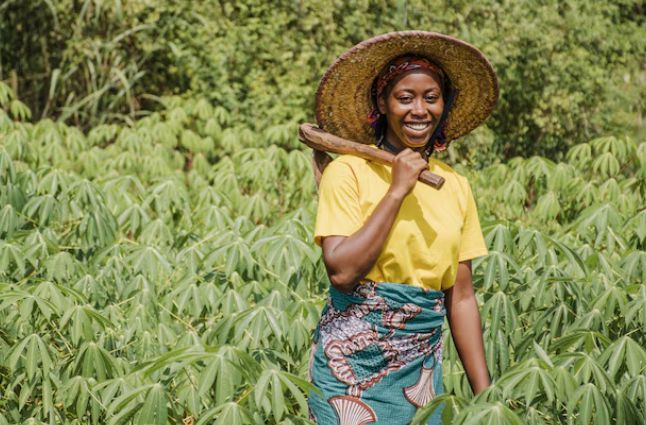
From planting and weeding to harvesting and processing, I’ve been part of the cassava value chain since childhood.
This hands-on involvement taught me more than any book could, and it’s why I’m passionate about sharing what cassava is and how it supports local economies.
Cassava isn’t just a crop; it’s a lifeline. It feeds households, drives trade, and links generations through farming knowledge.
If you’re wondering what cassava is and why it matters, my story has plenty to offer.
Related: Cassava vs yuca vs yucca
Botanical Description and Taxonomy of the Cassava Tapioca Plant
Cassava, scientifically known as Manihot esculenta, belongs to the plant family Euphorbiaceae, which includes other well-known species like the castor oil plant (Ricinus communis), poinsettia (Euphorbia pulcherrima), croton (Codiaeum variegatum), leafy spurge (Euphorbia esula), and Chinese tallow tree (Triadica sebifera).
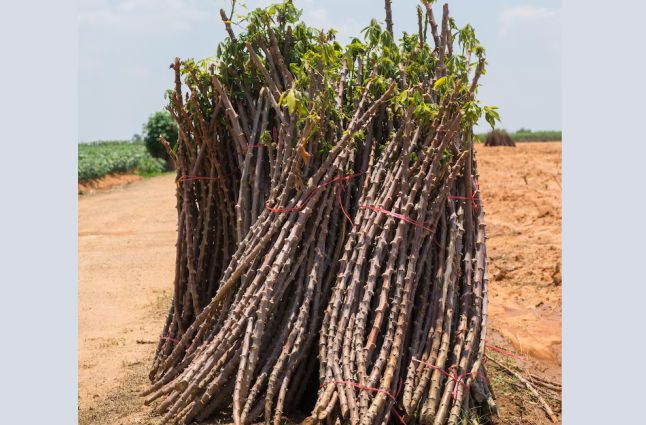
Cassava grows up to 2 to 4 meters tall and is prized for its thick, starchy tuberous roots, which serve as a key carbohydrate source.
The plant has palmately lobed leaves and produces small, inconspicuous flowers.
It thrives in well-drained, sandy-loam soils and is tolerant of poor fertility, making it a dependable crop for marginal lands.
Despite being a perennial, it is usually harvested as an annual due to its economic root value.
Physical Description of Cassava Plant
The yuca plant can be described by the obvious three parts: the stem, leaves, and roots. Let’s take a closer look:
Stem
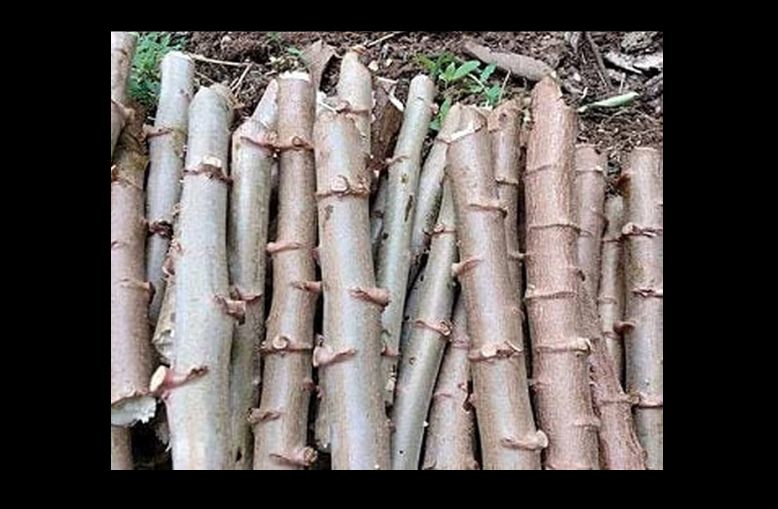
The stem of the cassava tapioca plant is woody and cylindrical, reaching up to 10 feet (3 meters) in height with an average diameter of 10 cm.
It is light brown or grayish, with bumpy nodes running along its length. These nodes serve as growth points where new shoots emerge during sprouting.
The stem is fibrous and hardy, allowing it to withstand drought conditions. The branches grow in an opposite pattern, forming a bushy appearance.
Cassava stems are not only used for propagation but also as fuelwood or, in some cases, animal feed after processing. For a detailed guide on cassava stems, read cassava stems: varieties and propagation
Leaves
Cassava leaves are palmate (hand-shaped) with 3 to 9 lobes, spreading outward like fingers.
They are deep green, though some varieties have reddish or purplish hues on the petioles.
The petioles (leaf stems) can grow up to 30 cm long, attaching the leaves to the main stem.
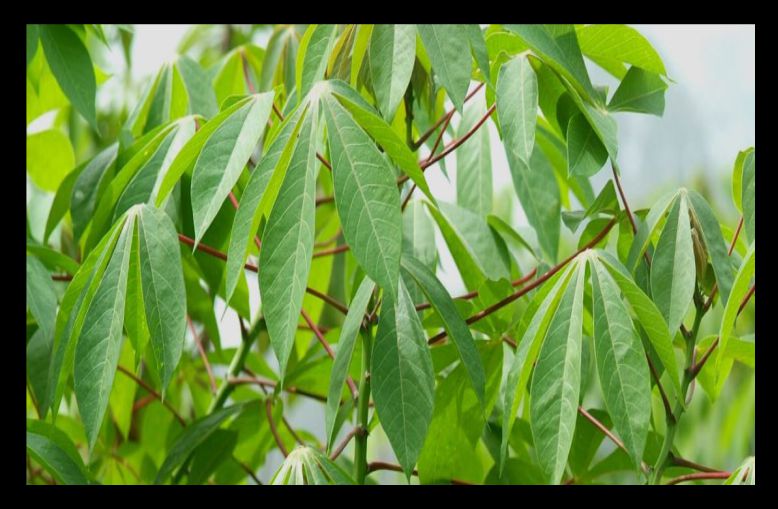
These leaves play a crucial role in photosynthesis, supplying energy for root development.
Nutritionally, cassava leaves are high in protein, vitamins A and C, and iron, making them a valuable food source in some regions, especially when cooked to neutralize toxins.
For detailed information on the cassava leaves, read our in-depth article here.
Roots/Tubers
The cassava tubers are elongated, cylindrical, and slightly tapered at the ends.
They grow underground in clusters, with each plant producing 4 to 10 tubers, depending on the variety and growing conditions.
The outer layer, or rind, is thin, detachable, and varies in color, typically brown, reddish, or white.
The inner flesh is firm, white, or yellow, and loaded with starch, making it a key carbohydrate source.
Cassava roots contain small amounts of calcium, phosphorus, and vitamin C, though they require proper processing to remove natural toxins before consumption.
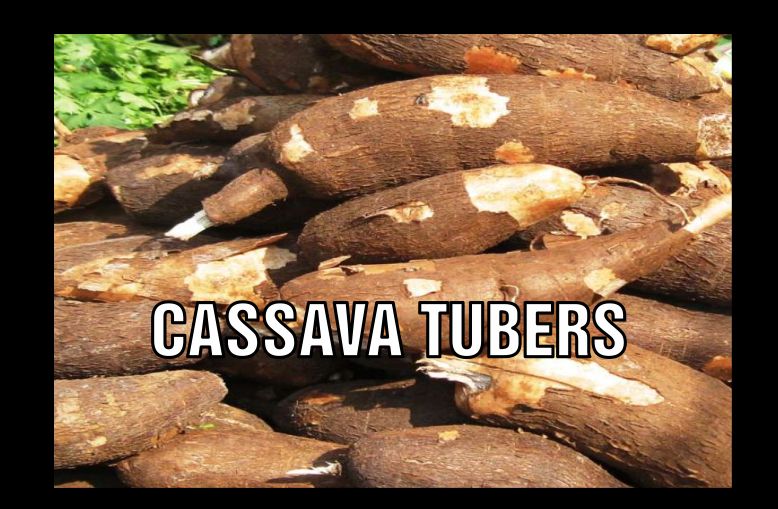
For a comprehensive guide on cassava tuber, including parts and anatomy, read our post on cassava tuber.
The cassava plant is susceptible to many cassava pests and diseases, including cassava mosaic disease, cassava brown streak disease, and more.
Using biological and chemical methods can get rid of pests and diseases.
The yuca plant must be properly prepared and the toxins gotten rid of before consumption, as it contains cyanide in reasonable quantities.
Related: Manioc Foods in Latin America
Nutritional Value of Cassava
Cassava is a calorie-dense staple rich in carbohydrates, making it an important energy source.
It contains fiber, which supports digestion, and vitamin C, which boosts immunity.
However, it is low in protein and healthy fats, so pairing it with protein-rich foods is essential.
Compared to rice and wheat, cassava provides more fiber but less protein.
While it is safe when properly processed, consuming raw or improperly prepared cassava can lead to cyanide poisoning.
Here’s a quick comparison table for cassava vs. other staple foods to include in the pillar page:
| Nutrient | Cassava | Rice | Wheat | Potatoes |
|---|---|---|---|---|
| Carbohydrates | High (~38g per 100g) | High (~28g per 100g) | High (~70g per 100g) | Moderate (~17g per 100g) |
| Fiber | Moderate (~1.8g) | Low (~0.4g) | High (~10g) | High (~2.2g) |
| Protein | Low (~1.4g) | Low (~2.7g) | High (~13g) | Low (~2g) |
| Fats | Very Low (~0.3g) | Very Low (~0.3g) | Low (~2.5g) | Very Low (~0.1g) |
| Vitamin C | High (~20mg) | Negligible (~0mg) | Low (~0.5mg) | High (~19.7mg) |
[Read the full nutritional breakdown here.]
Cassava and Food Security
Cassava plays a vital role in rural economies by providing both food and income for millions of smallholder farmers.
Its ability to grow in poor soils with minimal inputs makes it ideal for communities with limited resources.
Even without heavy fertilizer use, cassava produces reliable yields, making it a dependable food source during hard times.
As climate change affects rainfall patterns and soil conditions, cassava’s resilience to drought and poor soils helps keep farms productive.
This adaptability allows it to support the food supply when other crops fail.
Global bodies like the FAO and WHO recognize cassava as a strategic food crop for reducing hunger and improving rural livelihoods.
Its roots are rich in carbohydrates, and its leaves provide additional nutrients, making it useful in addressing both calorie and micronutrient deficiencies.
Cassava remains a steady pillar in the push for global food security.
Related: The Cassava Glycemic Index: Why You Should Be Concerned
How Cassava is Grown
Cassava farming begins with proper land preparation. The soil is cleared of weeds and debris, then tilled to improve drainage and aeration.
Raised beds or ridges are preferred in waterlogged areas.
Planting usually starts with the rainy season. Spacing cuttings 1 meter apart in rows spaced 1.2 to 1.5 meters apart allows good root development and airflow.
Cassava’s growth cycle runs between 6 to 18 months, depending on the variety. Most improved hybrids mature within 8 to 12 months.
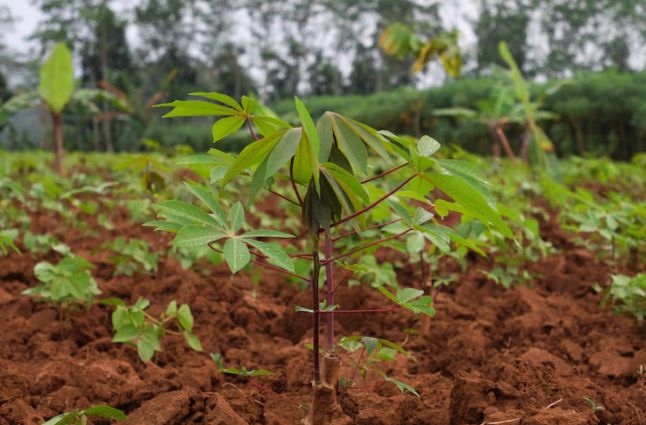
The cycle includes sprouting (1–2 weeks), leaf and stem development (2–4 months), and tuber formation (4–6 months onward).
Common threats include cassava mosaic disease, mealybugs, and whiteflies.
Farmers may choose between organic methods like compost and bio-pesticides, or conventional approaches involving chemical fertilizers and sprays.
Both systems aim to support healthy growth, but organic farming helps reduce soil degradation and promotes sustainability.
Once mature, the roots are manually harvested by loosening the soil and pulling them up.
Proper timing is essential, as delaying harvest can lead to fibrous, lower-quality roots.
For a detailed guide on cassava cultivation, including soil preparation, spacing, and pest control, read our in-depth article here.
Related: Is Cassava Good for You?
Cassava Harvesting and Post-Harvest Handling
Cassava is ready for harvest when the leaves begin to yellow and fall off, and the roots are thick with firm skins.
Depending on the variety, maturity takes 6 to 18 months as described in the previous section.
Delaying harvest too long can reduce quality and starch content.
Harvesting is usually done manually using hoes, cutlasses, or digging forks to avoid damaging the tubers.
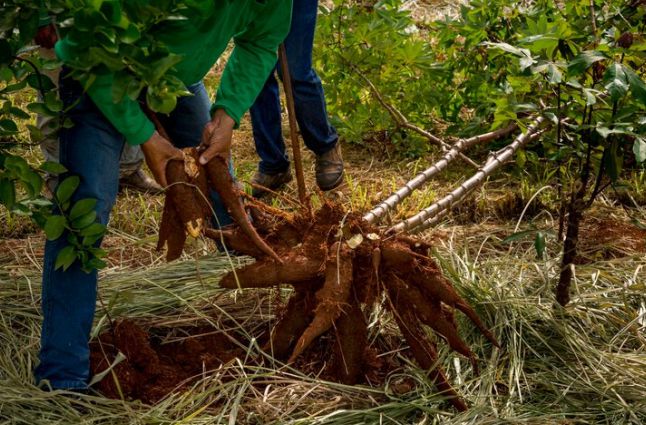
After lifting, the roots should be processed quickly since they deteriorate within 48 hours.
For short-term storage, keep roots in shaded, cool areas with good airflow. Longer storage may require processing into products like gari, flour, or starch.
Drying is done using sun-drying platforms, racks, or mechanical dryers.
Poor drying increases the risk of spoilage due to mold and microbial growth.
Proper handling during and after harvest is essential to preserve cassava quality and reduce post-harvest losses. See a comprehensive post on how to harvest cassava.
Traditional & Modern Uses of Cassava
Cassava is one of the most versatile crops, serving both dietary and industrial purposes. In traditional cuisine, it is a staple ingredient in many cultures.
The tubers are processed into various food products, including flour, garri, fufu, tapioca, and boba pearls, which are used in cooking and baking.
The leaves of the cassava plant are also highly nutritious and are consumed as a vegetable, particularly in African and Asian diets.
Beyond its role in food, cassava is a major industrial crop. Modified tapioca starch is widely used in the food industry for thickening and stabilizing products.
The textile, pharmaceutical, and paper industries also rely on cassava starch for its binding properties.
Additionally, cassava is emerging as a renewable energy source, with biofuel production gaining attention for its sustainability benefits.
The yuca plant is also used in the production of cassava flour, starch, ethanol, and animal feed. It’s a good business opportunity for entrepreneurs when the cassava value chain is in consideration.
Its hay is used as animal feed, and it plays a role in the adhesives, textiles, and cosmetics industry.
Read our more detailed breakdown of cassava’s traditional and modern benefits and uses.
Processing Cassava: From Root to Product
Cassava undergoes several processing steps to enhance its safety, shelf life, and versatility.
The process begins with peeling to remove the outer skin, followed by soaking and fermenting, which help break down naturally occurring toxins.
Drying and milling convert cassava into various forms suitable for consumption and industrial use.
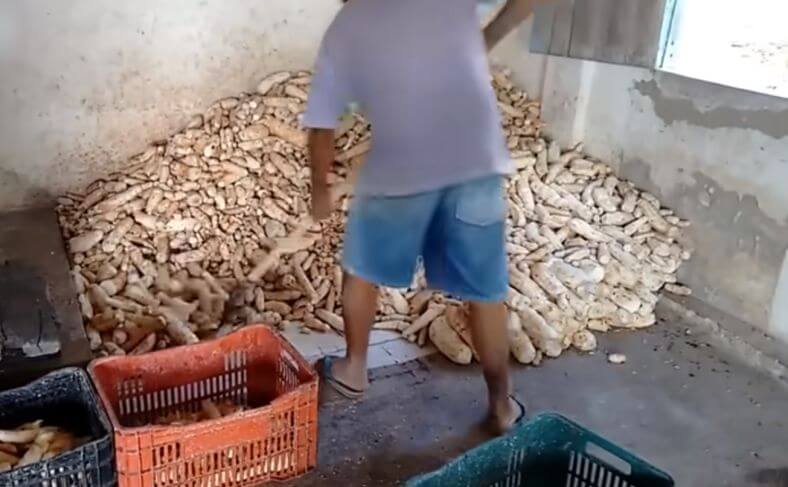
Popular Cassava Products
Cassava is transformed into a wide range of popular products across food and industry.
Cassava flour is a gluten-free alternative to wheat, used in baking and cooking. Garri, a fermented and roasted granule, is a staple in many West African homes.
Fufu, made by fermenting and pounding cassava, is a dough-like meal commonly served with soups.
Tapioca pearls, derived from cassava starch, are widely used in bubble tea and desserts.
Native cassava starch also serves as a thickener in food, paper, and textile industries.
These products not only support everyday meals but also drive processing, trade, and innovation across cassava-growing regions.
Each one adds value to the root, expanding its role far beyond subsistence farming.
Traditional vs Modern Techniques
Traditional cassava processing relies on sun-drying, hand-grating, and fermentation, while modern industries use mechanized drying, milling, and chemical treatments for efficiency and mass production.
These advancements improve product quality, reduce labor, and enhance food safety.
See our detailed article for a more in-depth look at cassava processing.
Recommended: The Many Different Names of Cassava
Economic Importance of Cassava
The adaptability of cassava to poor soils and resistance to drought make it an essential crop for food security and income generation.
Beyond household consumption, cassava is an integral part of local and international markets, contributing to global trade, industrial applications, and biofuel production.
This makes the cassava value chain a hub for many businesses to thrive.
From small-scale farmers to large agribusinesses, cassava supports economic growth by creating employment opportunities, strengthening agricultural supply chains, and serving as a valuable raw material in industries such as food processing, textiles, and bioenergy.
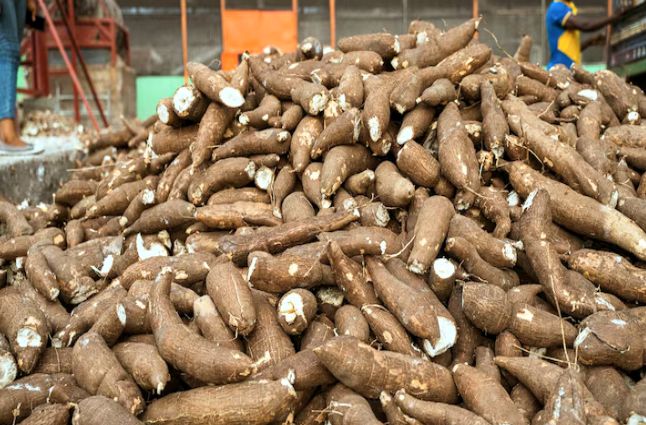
Leading Producers
The world’s top cassava producers include Nigeria, Thailand, Indonesia, and Brazil, each playing a critical role in the global cassava trade.
Nigeria is the largest producer, cultivating cassava primarily for food and local consumption, while Thailand and Indonesia focus on cassava processing and export, especially in the form of starch.
Brazil also contributes significantly, supplying cassava for both domestic use and global markets.
These countries invest heavily in cassava research, mechanization, and value-added processing to enhance productivity and profitability.
The increasing global demand for cassava starch and ethanol further solidifies these nations’ positions as industry leaders. See a dedicated article on the top producers of cassava in the world.
Livelihoods & Small-Scale Farming
Cassava farming is a lifeline for millions of smallholder farmers, particularly in Africa, Asia, and Latin America.
Its ability to grow in marginal soils with minimal inputs makes it an attractive option for low-income farmers seeking food security and financial stability.
In many rural communities, cassava farming is a primary source of income, supporting not only farmers but also traders, processors, and laborers along the supply chain.
Women play a significant role in cassava cultivation and processing, further enhancing its socio-economic impact.
Governments and NGOs continue to promote cassava as a tool for poverty alleviation and rural development.
Cassava in Global Trade
Beyond local consumption, cassava has grown into a major export commodity, particularly in the form of starch, flour, chips, and ethanol.
Countries like Thailand dominate the global cassava starch market, supplying industries such as food manufacturing, textiles, adhesives, and biofuel.
Cassava ethanol is also gaining traction as a renewable energy source, with countries investing in its production to reduce dependence on fossil fuels.
The growing global demand for gluten-free products has further boosted cassava’s trade value, making it a lucrative crop.
For a deeper analysis of cassava in the global market.
Challenges in Cassava Farming & Solutions
Despite its resilience, cassava farming faces several challenges that threaten productivity, profitability, and food security.
Farmers must contend with pests, diseases, post-harvest losses, and the unpredictable effects of climate change.
These challenges not only reduce yields but also impact the quality of cassava products, limiting their market value.
By addressing these challenges, cassava can continue to thrive as a staple crop and economic powerhouse for millions worldwide.
Cassava farming faces pests, diseases, post-harvest losses, and climate change. Innovations like disease-resistant varieties, better storage, and climate-smart agriculture help farmers maintain productivity and ensure food security.
Here are some of the challenges:
- Cassava Pests and Diseases: Cassava mosaic disease and brown streak virus stunt growth and reduce yields. Solutions include disease-resistant varieties, crop rotation, pest control, and biological methods like integrated pest management (IPM).
- Post-Harvest Losses: Cassava deteriorates within 48 hours after harvest, leading to losses. Improved drying, fermentation, mechanized processing, and better storage infrastructure help extend shelf life and increase profitability for farmers.
- Climate Change: Climate change affects cassava yields through rising temperatures and erratic rainfall. Drought-resistant varieties, conservation agriculture, irrigation systems, and soil fertility management support sustainable production.
Future Innovation in Cassava Farming
Biofortification for Enhanced Nutrition
Cassava biofortification is a groundbreaking innovation aimed at addressing malnutrition, particularly in regions where it is a dietary staple.
Scientists are developing cassava varieties enriched with vitamin A to help combat deficiencies that cause vision problems and weakened immunity.
These biofortified strains retain the drought resistance and high-yield properties of traditional cassava while offering greater nutritional benefits.
By integrating these enhanced varieties into local diets, communities can achieve better health outcomes without altering their traditional food practices.
Governments and agricultural organizations are working together to promote the widespread adoption of biofortified cassava.
Sustainable Agriculture Practices
Sustainable cassava farming focuses on improving soil health, increasing yields, and reducing environmental impact.
Intercropping with legumes enhances nitrogen fixation, while organic fertilizers improve soil structure and nutrient availability.
Rotational farming helps prevent soil depletion and pest infestations, ensuring long-term productivity.
Additionally, improved irrigation systems and agroforestry techniques contribute to cassava’s resilience against climate change.
Farmers adopting these methods experience higher yields and greater economic stability.
Governments and NGOs are supporting training programs to encourage the use of sustainable techniques for cassava cultivation, securing its future as a staple crop. [Insert link to cluster page].
Cassava in Global Food Security
Cassava plays a crucial role in global food security due to its ability to thrive in nutrient-poor soils and withstand harsh climates.
As the world’s population continues to grow, the demand for resilient, high-yield crops like cassava increases.
Research into drought-tolerant and pest-resistant varieties is helping farmers maintain steady production despite environmental challenges.
Additionally, cassava’s versatility in both fresh and processed forms makes it a reliable food source in developing nations.
With improved agricultural techniques and better distribution networks, cassava can contribute significantly to reducing hunger and stabilizing food supplies worldwide.
Environmental Impact & Sustainability
Soil Health Considerations
Cassava farming can deplete soil nutrients if not managed properly.
Sustainable practices like crop rotation, intercropping, and organic fertilization help maintain soil fertility and improve long-term productivity.
Adopting these methods prevents soil degradation while ensuring consistent yields, making cassava cultivation both productive and environmentally responsible. See more on soil
Water Usage & Drought Resistance
Cassava is highly drought-resistant and requires less water than crops like rice and maize. Its deep roots access underground moisture, allowing it to thrive in dry conditions.
Scientists are developing improved drought-resistant varieties to enhance its adaptability, making cassava a crucial crop for water-scarce regions.
Eco-Friendly Innovations
Cassava is used in biodegradable plastics, eco-friendly packaging, and biofuels, reducing reliance on petroleum-based products.
These innovations lower environmental pollution and promote sustainability.
Cassava waste is also being repurposed for green products, contributing to circular economies and positioning cassava as a key player in sustainable development.
Cassava in Global Cuisine (Cassava Recipes)
Cassava plays a crucial role in global cuisine, with unique preparations across different regions. See cassava recipes.
In Africa, it is processed into garri, a crunchy, fermented granule, and fufu, a smooth, dough-like staple paired with soups.
Cassava leaf stews are also popular, offering rich flavors and nutrients.
In Asia, it is widely used in tapioca pearls for bubble tea, cassava cakes, and various snacks.
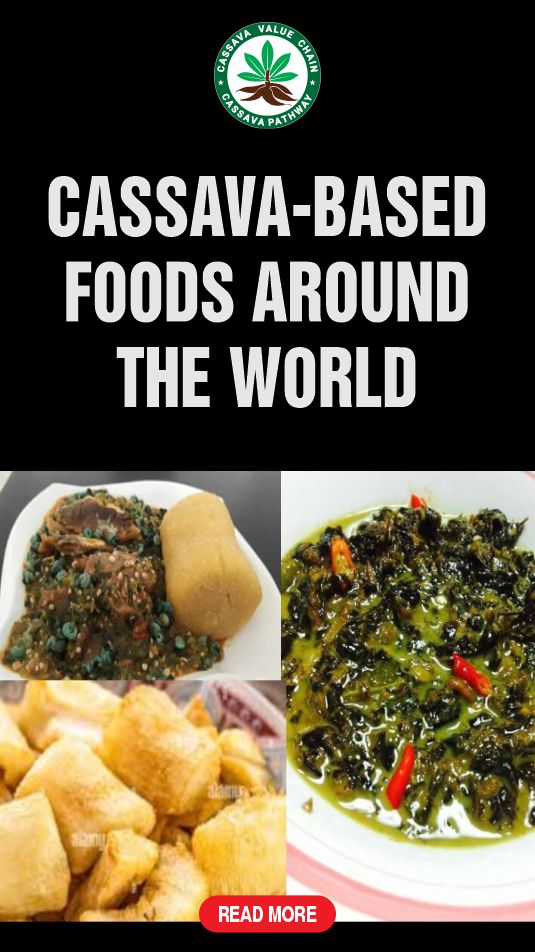
South America incorporates it into dishes like farofa, a toasted cassava flour side, and traditional cassava bread.
The Caribbean enjoys bammy, Jamaican flatbread, and sweet cassava pudding.
Cassava’s versatility allows it to be used in both traditional and modern cuisines worldwide. See a dedicated article on cassava-based foods around the world.
Health Concerns & Allergies of Cassava
Cassava is an important food source, but it comes with potential health concerns.
Some individuals allergic to latex may experience cross-reactivity with cassava due to similar proteins, triggering mild to severe allergic reactions.
Symptoms may include itching, swelling, or digestive discomfort.
Another major concern is its natural cyanogenic glycosides, which can release toxic cyanide if not properly processed.
However, traditional and modern processing methods, such as soaking, fermenting, drying, and boiling, effectively neutralize these compounds, making cassava safe to eat.
Myths surrounding cyanide poisoning often overlook the fact that properly prepared cassava has been safely consumed for generations.
Understanding these risks and using correct processing techniques ensures cassava remains a nutritious and safe staple.
Cassava Entrepreneurship (Business Farming)
Cassava farming presents a lucrative opportunity for entrepreneurs, given its high demand in food and industrial markets.
Starting a cassava farm requires access to arable land, high-yield stem cuttings, and proper management practices to ensure optimal growth.
With cassava being a staple crop in many regions, its market potential continues to expand, particularly in processed forms like flour, starch, and biofuels.
However, challenges such as limited funding, inadequate mechanization, and market accessibility can hinder profitability.
Solutions include seeking agricultural grants, investing in modern farming techniques, and establishing reliable distribution networks to maximize returns. See a detailed article on how to start cassava commercial farming.
Cassava, Plastics, Energy, and the Future
Cassava is no longer limited to food use; it’s also fueling innovation across industries.
One breakthrough is cassava-based plastic, made from cassava starch.
It’s biodegradable and offers an eco-friendly alternative to petroleum plastics.
In energy, cassava waste is now used to produce biogas.
Through anaerobic digestion, peels and processing leftovers generate renewable energy, helping rural communities reduce dependence on firewood or fossil fuels.
Cassava starch also plays a growing role in gluten-free food production.
Its fine texture and neutral taste make it a preferred choice for baking, thickening, and formulating foods for people with celiac disease or gluten sensitivity.
Researchers are also applying genetic engineering to cassava to improve traits like virus resistance, nutrient content, and starch quality.
These innovations aim to make cassava more productive, more nutritious, and more useful in the food, industrial, and energy sectors.
Cassava vs Similar Crops
Cassava shares space with many root and tuber crops in both farming and diets.
Understanding how it compares helps you choose what fits your land, climate, and end use.
Cassava vs Yam
Cassava and yam are both important food staples, but they differ in farming needs and shelf life.
Cassava grows in poorer soils with fewer inputs, making it easier for low-resource farmers.
Yams need richer soils and more labor,r but offer better taste and longer storage when properly cured.
Cassava matures faster and provides higher yields per hectare.
If your goal is food security and starch production, cassava may be the more dependable option, especially under tough conditions.
Cassava vs Sweet Potato
Cassava and sweet potato both serve as major carbohydrate sources, but sweet potatoes are higher in vitamins like beta-carotene.
Cassava offers more starch and performs better in poor soils and drought.
Sweet potatoes mature faster, usually in three to five months, while cassava takes six to eighteen months.
For quick harvests and home gardens, sweet potato works well.
But if you’re producing for processing or long-term supply, cassava’s yield and adaptability make it a stronger commercial crop.
Cassava vs Taro
Taro and cassava are both tropical root crops, but taro prefers wetter, shaded environments while cassava tolerates dry conditions and degraded soils.
Taro has a softer, stickier texture and is often used in traditional dishes, while cassava’s neutral flavor and high starch content suit industrial processing.
Taro requires more water and manual care, limiting its scale.
Cassava, on the other hand, supports larger farms with mechanized options.
If you’re aiming for scale and broader market use, cassava has more range.
Cassava vs Maize for Biofuel
Both cassava and maize are used for bioethanol, but cassava has an edge in regions with low rainfall and poor soils.
Cassava roots contain more starch per plant, making it highly efficient for ethanol production.
Maize, however, matures faster and is widely supported by existing infrastructure in many countries.
If you’re looking to produce biofuel in tropical areas with limited inputs, cassava is often a better fit.
Its waste can also generate biogas, adding to its renewable energy potential.
| Comparison | Cassava | Other Crop |
|---|---|---|
| Cassava vs Yam | Grows in poor soils, needs less labor, matures faster, offers high yield per hectare, ideal for food security and starch production. | Yam needs richer soil, more labor, and longer time to mature. It stores better and has better taste but requires more effort. |
| Cassava vs Sweet Potato | Offers more starch, better drought tolerance, and thrives in poor soil. Best for commercial scale and industrial processing. | Sweet potato matures faster (3–5 months), is richer in beta-carotene, and suits home gardens or quick harvests. |
| Cassava vs Taro | Tolerates dry soil, grows in harsh climates, ideal for large-scale farming and processing due to high starch content and mechanized options. | Taro needs wetter, shaded areas and more water. Has sticky texture, suited for local dishes but less scalable for commercial farming. |
| Cassava vs Maize for Biofuel | High starch yield, grows in poor soils, and cassava waste can generate biogas. Well-suited for ethanol in low-rainfall regions. | Maize grows faster, supported by better infrastructure, but needs more inputs and is less drought tolerant compared to cassava. |
Frequently Asked Questions
What is cassava?
Cassava is a starchy root crop known as yuca, mandioca, manioc, or tapioca, widely grown in tropical regions for food and industry.
Is cassava safe to eat raw?
No, raw cassava contains cyanogenic compounds, which can be toxic. It must be properly cooked or processed before consumption.
What are the health benefits of cassava?
Cassava provides energy, dietary fiber, and vitamin C, supporting digestion and immunity but should be combined with protein-rich foods.
How is cassava processed for food?
Cassava is processed through soaking, fermentation, drying, or cooking to remove toxins and improve texture and nutritional value.
What are the main uses of cassava?
Cassava is used for food products like flour, starch, and tapioca, as well as in biofuel, textiles, and animal feed industries.
Conclusion
We believe this post has been able to answer the question, “what is cassava.”
Cassava, also known as yuca, mandioca, manioc, or tapioca, is a lifeline for millions worldwide.
Its resilience in poor soil and drought conditions makes it a crucial food security crop.
From traditional dishes like garri and fufu to industrial applications in starch, biofuels, and textiles, cassava’s versatility is unmatched.
However, despite its benefits, challenges like cyanide toxicity, inefficient processing, and pests threaten its full potential.
Proper cultivation, modern processing techniques, and continued research can enhance cassava’s safety and productivity.
Whether you’re a farmer, entrepreneur, or food enthusiast, understanding cassava’s role in nutrition, economy, and industry offers insights into why it remains one of the most essential crops in the world today.
If you find this post helpful, it will also be helpful to others. Please share.
References
- ResearchGate: Studies on cassava plant micropropagation
- PMC: Cassava (Manihot esculenta Crantz): A Systematic Review for the Pharmacological Activities, Traditional Uses, Nutritional Values, and Phytochemistry
- Ripe: Research shows how to grow more cassava, one of the world’s key food crops
- ScienceDirect: Cassava in focus: A comprehensive literature review, its production, processing landscape, and multi-dimensional benefits to society
- The Applied Ecologist: Research into Cassava, a promising crop under climate change
